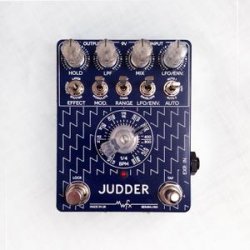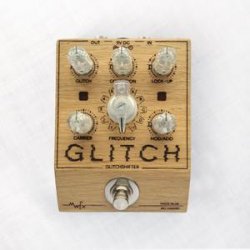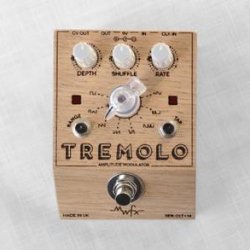
In an industry seemingly rife with stompbox clones and copies, British builder MWFX is creating some truly innovative guitar pedal designs. Some are based on familiar ideas, but most of their products are quite novel and allow you to access sounds that previously could only exist in your imagination.
Established in 2008 and based in Somerset, England MWFX designs stompboxes inspired by the golden age of synthesizers during the 1970s and 80s. Each unit offers a plethora of sounds, and if you’re looking for the same old guitar pedal format you may as well look elsewhere. While some might view the company’s offerings as esoteric at best, the more adventurous guitarist, bassist, or vocalist can find new tonal frontiers previous unavailable in most effects available on the market. Some might take quite a bit of tweaking to dial in for what your sound calls for, but there is a great variety of soundscapes located inside of each one.
The Judder is part echo, looper, and phrase sampler all rolled into one science experiment of a guitar pedal. It’s designed around analog chip technology to provide degrading repeats like those found in tape echo units. Utilizing an innovative switching system it can inject echo, time, modulation, and envelope manipulation to your signal. It does standard looping and phrase sampling well, but it’s meant for much more. It’s great for indie, shoegaze, electronic, and ambient styles or for adding a little science fiction into your set. It can also open up a universe of new ideas for people who score movies or add sound effects to film.
This is a slimmed down version of their flagship pedal with the most essential elements still intact. At its core it is a looper pedal that provides gradually decaying repeats, again similar to a tape echo. The sample length ranges from 27ms up to 200ms, and there is an optional control to increase this to over 10 seconds. The mode switch turns the pedal into a mute/kill switch and also gives the ability to layer sound on sound. Three simple controls set the parameters. A rotary knob selects the BPM, there is a toggle switch to select short or long range, and a 3-way switch to select Layer, Judder, or Stutter effect options.
A mix of pitch shifter and octave effect, Glitch lets you produce otherworldly sounds via an IC circuit design. The Glitch, Confusion, and Lock-Up controls affect how the input signal interacts with the circuit. There is a rotary switch to select the Frequency, setting how many octaves above the fundamental that the effect produces (up to 6!). You can set all controls to 0 to produce a standard octave up effect, but it is capable of so much more. It also responds to different styles of pickups, adding even more versatility to an already unique device.
Tremolo with Clock Input and CV Output
This is an alternate version of the Tremolo with some extra I/O features. All of the controls from the standard Tremolo are present, and additional features include a Clock input to sync the low frequency oscillator to a universal clock, and a CV output for sending the signal to an external synthesizer.
With multiple waveform options available, this is an op-amp based tremolo pedal. There are 8 waveform options total, including the fairly standard square, sine, and ramp waves. There are also rhythmic, random LFO, and 2-step wave settings. Knobs for Rate and Depth control the overall sound, and a unique Shuffle control manipulates the swing of the tremolo. There are 2 tap switches, one to adjust the tempo and one to multiply the rate.
This version of the Judder is also built around the same analog echo chip technology as the original, and provides the same tape echo sound. It features a wooden enclosure and a slightly different control layout, with some variation in the control scheme of the pedal. The control knobs and rotary BPM switch are the same as in the original, with five throw switches that further manipulate your sound. It houses the same dual footswitch design as the original, and there is added inputs for an external footswitch and expression pedal, which can be used to alter the length of the sample.
—
This manufacturer has also a list of upcoming designs, we list them here:
Tape
Give your signal some old-school analog vibe with Tape, a pedal that splits the signal into 3 bands, each with their own controls. Soft clipping via diodes is introduced to each frequency band, emulating the saturation, compression and warmth of using a tape machine. At lower gain settings it adds gentle compression, and it can even go into higher-gain territory, creating a thick distortion. Give your sound everything beloved about the analog tape days without sacrificing clarity.
Hard Sync
The Hard Sync falls somewhere between an auto wah and an envelope filter/generator, though it’s got quite a variety of sounds hidden inside of it. Two oscillators (one high pitched and one low) work in conjunction with the pitch of the guitar signal they are receiving to produce saggy, dying battery, fuzzed out sounds, synth wah wonkiness, and so much more. A variety of parameters let you shape the envelope. It’s not just a guitar pedal, it’s a sound effects pedal.
Distortion
Probably the most familiar design in the company’s lineup, the Distortion uses an all analog circuit topology to produce its clipping.
Retreat
Play with the attack and decay of your signal with Retreat. It can make a picked guitar sound like it’s being played fingerstyle, or it can remove pick sounds from your playing altogether. A switch on top of the pedal allows for the effect to engage on the attack or decay of the signal (at the beginning of your pick attack or the end). The Attack setting can mute or fade the volume as your pick connects with the strings, which can change the timbre of your playing style – essentially acting like a “softness” control.
Subdivide
Somewhat similar to the Glitch, this is an interesting take on a tremolo effect where the rate of the tremolo is related to the pitch of the note played. The higher the note, the faster the rate of the effect. The design of the circuit factors the cycles of the note played and then divides that based on the setting of the Range control. The variation of the Range control can go from 10 seconds to an incredibly short time. The fastest setting cuts off every other cycle of the signal, essentially cutting the signal in half. This division creates a realistic and usable tremolo effect. It works in an interesting way with the tempo and key of the signal to open up new sounds that are unavailable with a standard tremolo.
Bandsaw
Appropriately named, the Bandsaw is a high gain fuzz that provides blown out, sawtooth wave madness. It offers the normal gain and volume knobs with two 3-way switches for additional control over the saturation and clipping of the effect. A 3rd switch tailors the pedal to best work with lead guitar (single notes), rhythm guitar (chords), or bass guitar.
Wave Machine
Access synthesizer madness on your guitar with this part analog, part digital waveform generator. The analog section of the circuit uses transistors – similar to a fuzz pedal. Digital oscillators let you choose between 16 different types of waveforms throughout 4 octaves. Access a wide range of synth sounds with controls over bit rate, detuning, portamento, and by setting octave up or down.
It is polyphonic and works just as well with chords as it does with single note lines. It’s not just for guitar and is right at home on bass guitar, in a vocal chain, even for harmonica!
Bitrate
Bit crushers are common in the software world, but almost non-existent in hardware form. Standard bit crushers lower the bit depth of a signal, but Bitrate achieves its sounds by lowering the sample rate instead. This affects the high and low frequency content alike, creating jitter and unorthodox distortion within the signal. Think of it as a flawed audio conversion sound that is so wrong it’s right.
Comparator (8-Bit)
This is a gated fuzz built around a design that drops in fractions of an octave as the note fades out. The Timbre setting controls the harmonic content of the signal, varying from familiar 8-bit to a chopped up fuzz. The Shape control manipulates the range of the waveform between square and saw waves. The signal is then fed into the Filter control to tailor the EQ. – Brandon Stoner


























